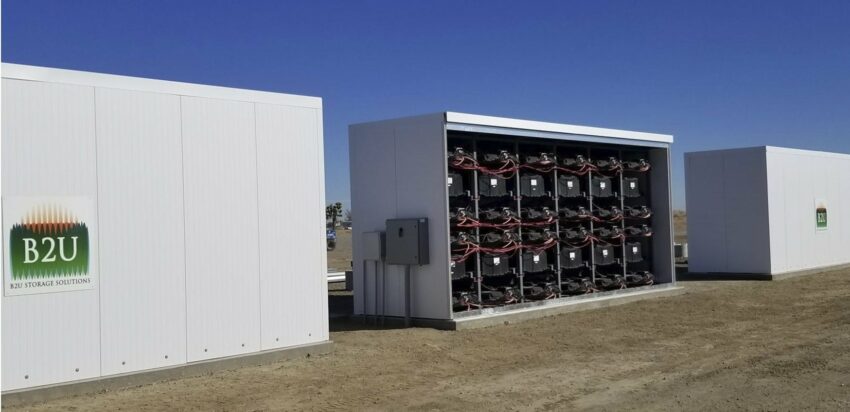Utility scale energy storage is becoming more prevalent across many US states. Large energy producers understand that the ability to scale and deploy energy – especially that which is produced by solar, wind and other renewables – optimizes both the grid and their own business. Climate tech and renewables PR firm FischTank PR recaps the utility scale energy storage news from the past couple weeks:
Chart: The US battery market is on track for its best year yet – Canary Media
Grid batteries accounted for most of the new installations in Q1. And almost all of this 993 MW of new utility-scale storage capacity was built in three states: Texas, arguably the hottest grid battery market in the country; California, the state with the most storage capacity; and Nevada, a state with ample solar and some momentum in battery deployments. In the residential and commercial markets, California led the way as well.
This wave of battery storage installations comes on the heels of exponential growth in U.S. solar capacity. A decade ago, the U.S. had connected around 20 GW of solar to the grid in total; now the country installs more than that each year. This growth can, at times, lead to an embarrassment of riches: Solar-saturated states like California often produce more clean electricity than they can immediately use. Without batteries to soak up this surplus, a lot of carbon-free energy goes to waste.
Microgrid at Marine air base will test long-duration energy storage viability – Power Engineering
ESS Tech, a manufacturer of long-duration energy storage (LDES) systems for commercial and utility-scale energy storage applications, announced that it will participate in a utility-scale microgrid project at a Department of Defense (DoD) base.
The Rapid Integration and Commercialization Unit (RICU) at Marine Corps Air Station Miramar is a living laboratory for testing how leading LDES technologies can be integrated into utility-scale microgrid applications. The RICU is a venture between Indian Energy, the California Energy Commission (CEC), and the DOD to validate LDES technologies.
Phase 2 of research at the RICU was funded by the CEC in May 2024 through a $4.85 million agreement between the CEC and Indian Energy to demonstrate the capabilities of LDES technologies. The partnership with Indian Energy lays the foundation for deployment on CEC grants and DOD installations.
Dispatch to build Netherlands’ ‘largest’ 45 MW/ 90 MWh standalone BESS – Emerging Technology News
Dutch battery developer Dispatch recently announced the construction of the Netherlands’ ‘largest’ stand-alone Battery Energy Storage System (BESS), in collaboration with system integrator Fluence and utility Eneco. Construction is set to commence in the coming months.
The 45MW/ 90MWh utility-scale BESS will be located in the port area of Dordrecht, and will be used for grid stabilization by storing excess energy from renewable sources. Eneco will be optimizing the 2-hour battery system across various power markets.
The proposed battery storage facility, consisting of 144 Fluence cubes, has a capacity of 90 MWh and will on average store the energy supply equivalent for 21,500 households per day.
Governor of Rhode Island Signs the 2024 Energy Storage Systems Act Into Law – T&D World
Some important features of the Act are as follows:
- Storage Targets: Rhode Island sets goals of 90 MW of energy storage by 2026, 195 MW by 2028, and 600 MW by 2033.
- Infrastructure Programs: The Rhode Island Infrastructure Bank will develop programs to facilitate energy storage adoption across all sectors.
- Storage Procurements: Enables the RI Public Utility Commission to require distribution companies to procure cost-effective storage systems.
Policymakers are delivering on their commitments to grow Rhode Island’s clean economy and reduce greenhouse gas emissions by signing the Energy Storage Systems Act (Senate Bill 2499 and House Bill 7811).
New report outlines possibilities of permanent California solar + storage “resilience hubs” – Solar Power World
A new study in the journal Risk Analysis finds that strategically placing resilience hubs throughout California could generate up to 8 GW of solar energy and lower the state’s carbon emissions by 5 million tons per year.
Power outages are on the rise nationwide as climate change brings more frequent wildfires, heat waves and severe weather events. The Federal Emergency Management Agency (FEMA) and the state of California have both recently established funding to help communities create “resilience hubs” that rely on solar + battery systems to provide emergency power for residents.
Located in community facilities like schools, community centers, libraries, and places of worship, resilience hubs provide power to residents for critical services such as phone charging, cool air and powering medical devices. Because resilience hubs are permanent (compared to emergency relocation centers), they can provide year-round services to address the vulnerability of at-risk and disadvantaged populations.
Chinese utility announces opening of large-scale battery storage facility: ‘The battery tech will continue to improve’ – The Cool Down
And as Gao Like, a manager at the Guanxi branch of China Southern Power Grid told Electrek, “The energy conversion efficiency of its sodium-ion battery energy storage system exceeds 92%. It’s comparable to the efficiency of common lithium-ion battery storage systems, at 85% to 95%.”
Sodium-ion batteries are outside the norm in the storage industry, but they’ve gained attention due to lower costs and sustainability. The main ingredient is said to be 500 times more abundant than lithium and can easily be harvested from seawater. It’s also environmentally friendly and safer to transport than lithium. Another interesting thing about sodium-ion batteries is that they can charge much faster than their lithium competitors. The utility shared with Electrek that the particular battery cells they use “charge to 90% in a mindblowing 12 minutes.”
The low price point has even made the tech alluring to budget EV makers with grand plans, such as China’s BYD, which has partnered with Huaihai Holding Group to power more affordable micro vehicles. And while they typically have lower energy density and shorter lifespans, some researchers have been working to improve those shortcomings.
SaskPower’s First Battery Energy Storage System Now Online – T&D World
SaskPower’s utility-scale BESS at its Fleet Street substation in Regina is operational, providing added flexibility to the provincial grid and supporting the company’s net-zero GHG emissions efforts. The BESS has capacity to provide 20 MW of power to the grid, equivalent to power up to 20,000 homes for one hour.
The BESS will help SaskPower balance the power system when demand increases for short periods of time. It will also help support the further deployment of intermittent generation options such as wind and solar.
New York PSC adopts energy storage road map detailing path to 6 GW by 2030 – Utility Dive
New York will deploy 6 GW of energy storage by 2030 under a framework approved Thursday by the New York Public Service Commission, the office of Gov. Kathy Hochul, D, said in a press announcement. The 6 GW storage target represents at least 20% of New York’s peak electricity load and could trim nearly $2 billion from projected future statewide electric system costs as New York works toward generating 70% of its electricity from renewable sources by 2030, the announcement said.
The road map aims for 3 GW of new bulk, or utility-scale, storage to be procured under the state’s new competitive Index Storage Credit mechanism and 1.5 GW of new retail storage, both for assets with discharge durations up to four hours, the announcement said. The road map earmarks at least 35% of the program’s estimated cost of up to $1.98 billion for projects that benefit disadvantaged communities and reduce emissions from fossil-fueled peaker plants.
Big batteries are solving a longstanding problem with solar power in California. Can they do the same for Australia? – The Conversation
In the United States, California is showing there is a clear solution – use grid-scale batteries to store excess solar power for use later that evening. This year, the Golden State has enough battery storage to begin pushing gas out of the grid in the evenings.
Authorities in California have been wrestling with the duck curve for years. The state is an economic giant – the fifth largest economy in the world – and has one of the world’s largest state grids, with a large and mature solar market. Solar and batteries are a natural fit. Pairing them offers a win-win model for future energy grids, turning cheap but time-limited electricity from solar into a much more versatile commodity: electricity on demand.
Sungrow conducts unprecedented fire test on utility-scale battery array – Solar Builder Magazine
In a first-of-its-kind test, Sungrow demonstrated the safety of its PowerTitan energy storage system. The company intentionally lit a full-size 20-ft standalone PowerTitan BESS on fire to ensure it could successfully contain “thermal runaway” without it spreading to other BESS units.
Sungrow livestreamed the burn test, which was conducted on May 23 at a third-party lab in Puyang, Henan Province, China. The company simulated a real energy storage plant scenario, purposely setting a complete PowerTitan on fire without external fire control measures to assess its impact on adjacent units. This test checked PowerTitan’s fire safety capability at both the BLOCK and station control levels.
Ireland utility-scale energy storage forecast to exceed 1.5GWh in 2025 – Energy Storage News
Year-on-year additional capacity built this year remains at a steady rate; 720MWh of energy storage was operational at the end of 2023 and cumulative operational capacity is predicted to reach over 1.7GWh by the end of 2025. The growth of the energy storage market in Ireland has been rapid, considering the first project was only energised in 2020.
In particular, the pipeline increased by over 4GWh in 2023, a growth of 75% compared to 2022. The first half of 2024 shows further promise that this strong growth will continue, with 2.5GWh already submitted and over 1.5GWh of additional storage forecast to be connected to the grid by the end of 2025. This growth trend underscores Ireland’s commitment to expanding its energy storage infrastructure.
Looking for PR for your utility scale energy storage news?
FischTank PR has worked with a number of companies deploying utility scale energy storage technologies including developers, tech providers, utilities and more. If you’re interested in discussing a media relations and PR program for your brand, contact [email protected].
***Utility scale energy storage news roundup guest post from FischTank PR interns Baylee Matthews and Uju Ike***




